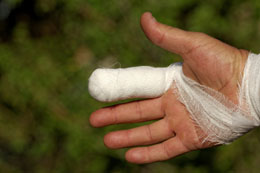The majority of finger fractures are treatable without causing any further medical complications. The healing time required for a broken finger may be about 4 weeks for children and 6 weeks for adults, provided that the instructions given by the doctor are followed carefully and correctly.

A broken finger is a troubling condition resulting from a crack or a fracture in the finger bone. Since fingers are frequently moved or are involved in doing even the smallest of tasks, they are very susceptible to fractures, which are undoubtedly very painful. In addition to the intense pain, the worst part is that it disturbs the regular day-to-day activities that we all indulge in. Nevertheless, the time required for healing a broken finger can be shortened with proper self-care tips from the patient's side.
Symptoms and Time Required
The symptoms of a broken finger include pain, bruising, numbness, swollen finger joints, and disorientation of the finger. As with any type of bone-related injuries, the recovery time of a broken finger differs with respect to the type of bone affected, extent of damage, and the age of the patient. For example, it takes about a month's time for children, while it takes about 6-8 weeks for adults. The exact length of time required for treating fractured fingers also depends on how the patient handles the condition.
Needless to say, keeping the affected portion undisturbed is the thumb rule to encourage the proper healing of the joints. Failure to do so will exacerbate the swelling and inflammation. People tend to use their fractured fingers for doing simple tasks, which in turn worsens the condition and disturbs the healing process. However, as we all know, allowing the broken finger to rest without disturbing is easier said than done.
Tips to Shorten the Recovery Period
Act immediately after the fracture occurs, and remove any jewelry worn on the dislocated finger. As the affected portion swells up, it may be difficult and painful to remove the same afterwards. Additionally, wearing a tight ring will negatively affect your blood circulation and the overall healing process. In case of already swollen fingers, applying ice and cold compresses will help in reducing inflammation. Discussed below are some effectual tips concerning treatment and recovery.
- The first and foremost thing is to use a finger splint. This helps in immobilizing the fractured bone and aligning the adjacent bones properly.
- In case of severe pain, applying ice packs for about 15 minutes is a good remedy for instant relief. It numbs the swollen finger and reduces inflammation. However, remember to wrap the ice in a soft cloth or towel.
- Continue applying cold compresses or ice packs for the first 15 days. Reducing the swelling and inflammation is an effective remedy to promote quick healing.
- Wearing a finger sling reduces the pressure on the affected portion. Hence, if possible, use a finger splint and a sling to shorten the recovery period considerably.
- Your doctor will most probably recommend wearing the finger splint for 2-3 weeks, which is the time by when the fractured bone heals. Usually, the splint is removed after three weeks.
- Last but not the least, follow the guidelines recommended by the orthopedic doctor or general physician in order to ensure quick healing and complete recovery of the broken finger.
These were some tips which you can follow for quick recovery. Even if you get a sprained finger, addressing the problem as soon as possible is imperative in order to manage the injury effectively. So, do not delay getting medical attention. Based on the severity of the break, the doctor will determine the prospective healing time. If required, a surgical procedure might be performed to keep the dislocated bone in place.
Disclaimer:
This Buzzle article is for informative purposes only, and should not be used as a replacement for expert medical advice.


 A broken finger is a troubling condition resulting from a crack or a fracture in the finger bone. Since fingers are frequently moved or are involved in doing even the smallest of tasks, they are very susceptible to fractures, which are undoubtedly very painful. In addition to the intense pain, the worst part is that it disturbs the regular day-to-day activities that we all indulge in. Nevertheless, the time required for healing a broken finger can be shortened with proper self-care tips from the patient's side.
A broken finger is a troubling condition resulting from a crack or a fracture in the finger bone. Since fingers are frequently moved or are involved in doing even the smallest of tasks, they are very susceptible to fractures, which are undoubtedly very painful. In addition to the intense pain, the worst part is that it disturbs the regular day-to-day activities that we all indulge in. Nevertheless, the time required for healing a broken finger can be shortened with proper self-care tips from the patient's side.